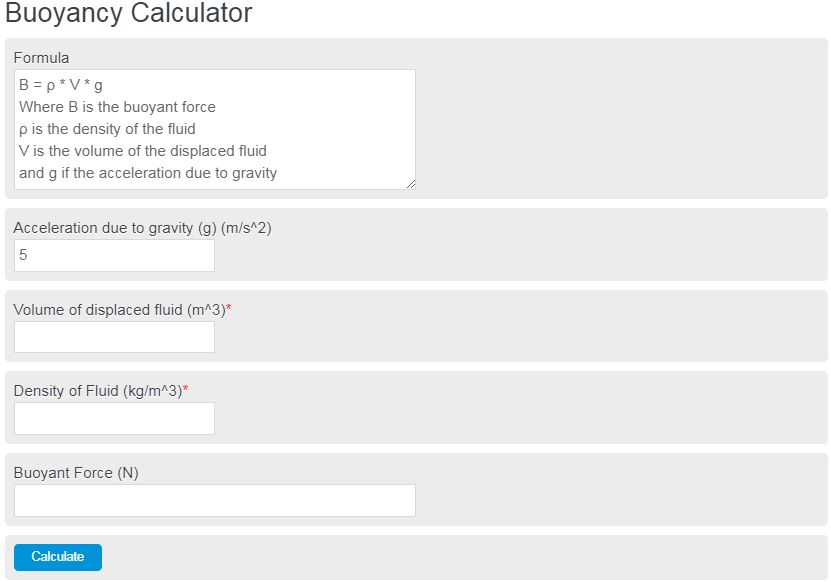Calculate the total force of buoyancy acting on an object. Enter the density of the fluid and the volume of the displaced fluid to calculate the buoyancy force.
- Gravitational Potential Energy Calculator
- Pressure Calculator
- Specific Gravity Calculator
- Hydrostatic Pressure Calculator
- Hydrostatic Force Calculator
- Buoyancy Acceleration Calculator
Buoyancy Formula
The following formula can be used to calculate a force due to buoyancy:
B = ρ * V * g
- Where B is the buoyant force
- ρ is the density of the fluid
- V is the volume of the displaced fluid
- and g is the acceleration due to gravity
To calculate the buoyancy force, multiply the density of the fluid by the volume of displaced fluid, and then by the acceleration due to gravity.
Buoyancy Definition
Buoyancy is the force acting on an object in a fluid that prevents it from moving through the liquid or sinking. Typically the movement it’s resisting is sinking due to the gravity of the earth. Buoyancy is directly proportional to the density of the fluid and the volume of displaced fluid as you can tell through the equation presented above. Buoyancy is evident mostly in bodies of water, but can also be seen in the air when objects like balloons float upwards away from the earth. This is due to the buoyant force.
How to calculate buoyancy
The following example will go over a real-world example of how to calculate the buoyancy force on an object.
- The first step to calculating this force is to choose a gravitational acceleration you wish the force to oppose Most of the time you are observing a force on earth, so the gravitational constant would be 9.8 m/s^2. If the
- Next, choose a liquid and determine the density of the fluid either empirically or mathematically.
- Finally, place the object in the water and observe the total displaced water.
Enter all of the values into the equation or calculator above, and you have your buoyant force.
FAQ
What factors affect the buoyant force on an object?The buoyant force on an object is affected by the density of the fluid, the volume of fluid displaced by the object, and the acceleration due to gravity. Changes in any of these factors can alter the buoyant force experienced by the object.
Can buoyancy occur in gases as well as liquids?Yes, buoyancy can occur in both gases and liquids. While it is most commonly observed in liquids, buoyant forces also act on objects in gases, such as balloons or airships floating in the atmosphere, due to differences in density.
How does the shape of an object affect its buoyancy?The shape of an object can affect its buoyancy by influencing the volume of fluid it displaces. While the buoyant force itself depends on the volume of displaced fluid, an object’s shape can determine how much fluid it displaces and thus its overall buoyancy. However, the shape does not directly enter into the buoyancy formula; it’s the displaced volume that matters.

